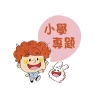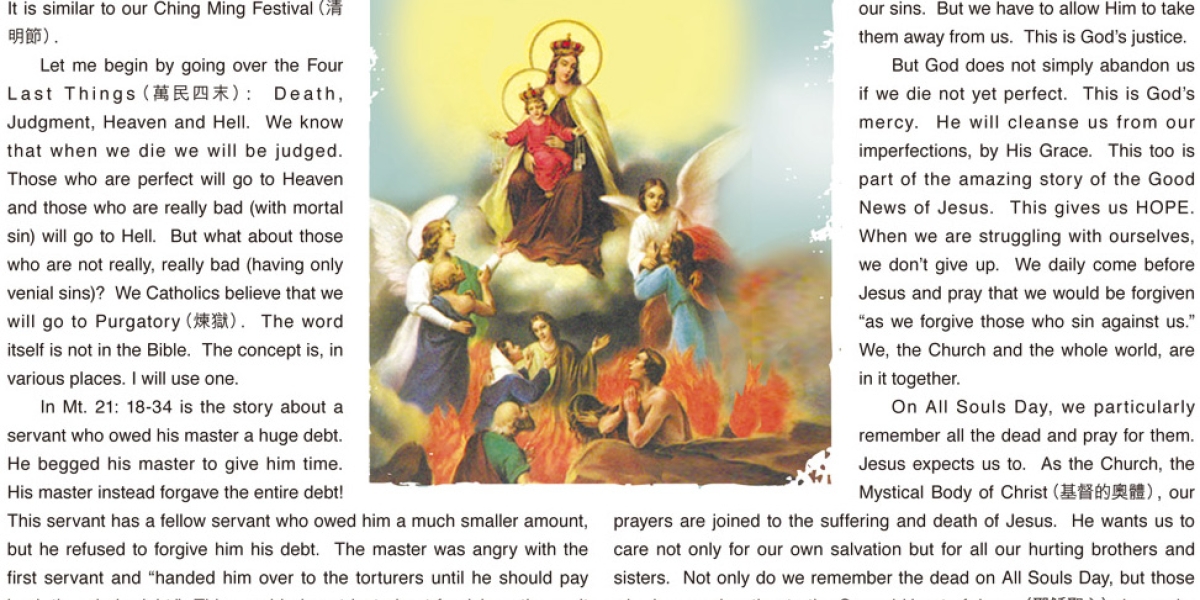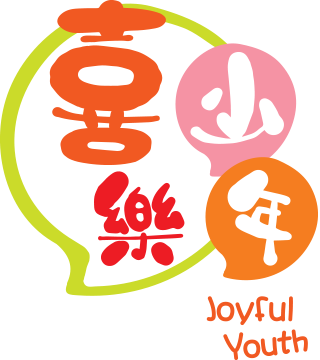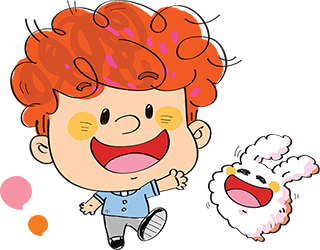昔日文章


Stories behind famous saysings
2016.10.29
Make someone’s hair stand on end
Tomorrow (31st October) is Halloween (萬聖節), also known as All Saints’ Eve. Traditionally, Halloween was a holy day before All Saints’ Day(諸聖節)on 1st November and All Souls’ Day(追思已亡節)on 2nd November. All Saints’ Day reminds us to stay away from evil and live as saints. All Souls’ Day invites us to pray for the souls of the dead, particularly our relatives and friends.
In recent years, the celebration of Halloween has spread from Western countries to Hong Kong. A lot of shops put up Halloween decorations to attract customers. Which one makes your hair stand on end? Hanging skeletons, black spiders or green paper pumpkin lanterns?
When something “makes your hair stand on end”, it means that something scares you very much. This idiom was created by William
Shakespeare(威廉.莎士比亞), the greatest writer in the English language, in one of his plays, “Hamlet” (《哈姆雷特》;《王子復仇記》).
“… I could tell a tale whose lightest word would … freeze your young blood, make your eyes start from their sockets and your hair stand up on end ….”
「我有一故事相告, 它會令你……血液凝固、雙目暴凸、毛髮直豎……」
Here, Shakespeare used some vivid imagery via the mouth of a ghost. In fact, when we feel very frightened, our skin gets tight and pulls our hair upright. The condition is known as “goose bumps”, “goose pimples” or “goose flesh”. Thus, we can use these phrases interchangeably to describe our fear.
The girl’s scream gave us the goose bumps / goose pimples / goose flesh (雞皮疙瘩).
The girl’s scream made our hair stand on end (毛骨悚然).
Glossary
Evil 邪惡
Skeletons 骷髏
Pumpkin lanterns 南瓜燈籠
Scares 嚇
Plays 戲劇
Vivid imagery 生動的意象
Upright 豎立
Interchangeably 互換


小學專題
2014.02.23
復修舊鹽田 建儉樸中心 西貢鹽田梓 繼往開來 傳頌主愛 2
從碼頭出發,展開 鹽田梓之旅。
小島面積不足一平方公里,卻處處蘊藏宗教、文化歷史和自然生態的瑰寶,
令人目不暇給。(澄)
百年老樹
村公所前長著一棵粗壯的老樟樹,已有百年歷史。枝葉茂盛成蔭,這卻是一株空心老樹。根據樹藝師的分析,此樹還有約三十年壽命。它見證鹽田梓的歷史,也將陪伴這客家村莊走向未來。
澄波學校
該校於1920年建立,是島上唯一的學校,教育村內及西貢孩童。學校共有兩個課室,採用複式教學, 不同年級的學生共用課室;老師同時兼顧不同年級,一班上課時,另一班則自習、寫作業。隨著村民遷離,學校亦空置了一段時間。現在則用作文化資源展覽室,陳列村民昔日的生活用品,介紹客家文化。
聖若瑟小堂
已有123年歷史的聖若瑟小堂是羅馬式的村鎮教堂,教堂內的祭台富中國色彩,亦保存梵二前禮儀的特色,為聯合國保護文物。此教堂於1890年、來自奧地利的聖言會福若瑟神父到鹽田梓傳教時落成祝聖。福神父曾於香港傳教兩年,包括鹽田梓,又學習客家話。他其後調往山東,並於該省染病逝世。2003年,教宗若望保祿二世冊封他為聖人。
活井泉水
此井是早年島上的唯一食水來源,供應清甜的淡水。直至六十年代,村民為解决食水需求,便自行鋪設水管,村內才使用自來水。
小聖堂遺址
聖若瑟小堂建成以前, 早於1 8 6 4年已有神父到鹽田梓傳教,並興建小聖堂,部份村民領洗入教。小聖堂是神父宿舍,也是舉行彌撒和信友祈禱的地方。現時遺址牆上仍可見方形洞孔,相信是昔日嵌入橫樑之處。
墳場
穿過一片竹林後是鹽田梓的墳場,那裡有一個十九世紀運來香港、由愛爾蘭藝術家設計的十字架,像船舵,也有像嫩芽的圖案。每年諸聖節,村民都會來為祖先獻彌撒。
山頂
小島十分平坦,最高點也只有四十米。但沿路走到山頂,視野豁然開朗,在涼亭可以眺望隔鄰的滘西洲,也可以看見附近水域的烏頭產卵勝地。
玉帶橋
昔日村民要到滘西洲取草料養牛和作燃料等,他們會趁水退時涉水過灘, 易生意外。因此,村民合力建造堤壩連接兩島,又稱為玉帶橋。橋旁的泥灘也是村民的糧倉,他們昔日在那裡摸蜆、捉魚、捉蟹。開揚的景致和輕輕的海風,使這橋今天成為島上參觀者安靜心靈的好去處。
紅樹林
鹽田梓的紅樹林更是香港六大紅樹林之一,有五十多個紅樹品種,當中更不乏罕有品種, 甚具生態價值。
鹽田
當年陳氏祖先移居鹽田梓, 開墾鹽田,利用水流法產鹽為生。潮漲時海水經水閘流入鹽田,多餘海水則由另一水閘排出,經日曬風吹,就能產出海鹽。1920年時鹽田停產,現正進行復修,期望於月內完成。


Neither East Nor West
2011.10.28
Purgatory 煉 獄
May the souls of all the faithful departed,
Through the mercy of God,
Rest in peace. Amen.
Last year I wrote about All Saints Day(諸聖節). We also looked at what “ghost” was about, that there was no such thing as haunting ghosts.
This year I will write about November 2, All Souls Day (追思亡者節). On that day we pray for all those who have died. It is similar to our Ching Ming Festival(清明節).
Let me begin by going over the Four Last Things(萬民四末): Death, Judgment, Heaven and Hell. We know that when we die we will be judged. Those who are perfect will go to Heaven and those who are really bad (with mortal sin) will go to Hell. But what about those who are not really, really bad (having only venial sins)? We Catholics believe that we will go to Purgatory(煉獄). The word itself is not in the Bible. The concept is, in various places. I will use one.
In Mt. 21: 18-34 is the story about a servant who owed his master a huge debt. He begged his master to give him time. His master instead forgave the entire debt! This servant has a fellow servant who owed him a much smaller amount, but he refused to forgive him his debt. The master was angry with the first servant and “handed him over to the torturers until he should pay back the whole debt.” This parable is not just about forgiving others. It also points to the judgment we will face when we die. The question is: where is this place of torture where we will not be released “until we pay back the whole debt?” This could not be Hell where there is no escape. This “place” is called purgatory where we will be purged, gotten rid of, any debt we still owe to God.
We already looked at how, at our judgment, any of the sins we have committed AND confessed will no longer be held against us. What are left, venial sins, penance not done, remain our responsibility. True, Jesus died for ALL our sins. But we have to allow Him to take them away from us. This is God’s justice.
But God does not simply abandon us if we die not yet perfect. This is God’s mercy. He will cleanse us from our imperfections, by His Grace. This too is part of the amazing story of the Good News of Jesus. This gives us HOPE. When we are struggling with ourselves, we don’t give up. We daily come before Jesus and pray that we would be forgiven “as we forgive those who sin against us.” We, the Church and the whole world, are in it together.
On All Souls Day, we particularly remember all the dead and pray for them. Jesus expects us to. As the Church, the Mystical Body of Christ(基督的奧體), our prayers are joined to the suffering and death of Jesus. He wants us to care not only for our own salvation but for all our hurting brothers and sisters. Not only do we remember the dead on All Souls Day, but those who have a devotion to the Sacred Heart of Jesus(耶穌聖心)also make an effort to go to Mass and pray for the souls in purgatory on first Fridays of the month. St. Margaret Mary Alacoque(聖瑪加利大) tells us that if we do that, we will not be deprived of a priest at our death. What a comforting thought!
Fr. Thomas Au 區耀邦神父


